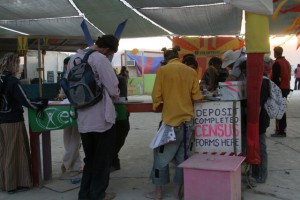The past year has been a particularly eventful, if not unnerving, year for understanding the “life cycle” of organizations. Researchers argue that new organizations suffer from the “liability of newness” problem.* They lack sufficient infrastructure, legitimacy, and resources, and they are thus vulnerable to threats from regulators, competitors, and suppliers that can lead to organizational closure. The Burning Man organization has, at various points, faced such threats. With a combination of luck and support, it has survived its early years.
However, even well-established organizations may be unable to surmount problems. Some organizations die “quickly.” The collapse of a key banking and investment organization Bear Stearns over one weekend, and the subsequent frenzy of survival-oriented activity in other similar firms in the ensuing weeks as confidence weakened, took most people by surprise. Other organizations fail “slowly.” State intervention (i.e., the on-going General Motors bail-out) may prolong these organizations’ survival. Without such state activity, various large airline firms, railroad companies, and car manufacturers would have died years ago.
Competition from other organizations may accelerate decline. Such a selection process is evident in the disappearance of local independent bookstores.** In my old neighborhood, several independent bookstores folded over the course of a decade, leaving only one, my favorite (the Harvard Bookstore) standing. In my current neighborhood, with the recent closure of an independent bookstore, only two independents, Book Culture and Bank Street Books, remain. Large online firms don’t bear the high cost of storefront rent, and they have more muscle to negotiate with publishers. With these advantages, online firms have usurped independents. Independents that have managed to hang on (so far, at least) often rely upon a unique identity and appeal to attract supporters. Given Burning Man’s “unique” output of a week-long arts community, it’s difficult to imagine how competitors can edge Burning Man out.
More commonly, organizations that do survive their early and mid years face a succession and growth challenge. As original founders retire or are forced out, remaining members and new members may falter. As the organization grows in size, remaining members may miss the intimacy of the original organization, and newcomers may wonder what is so attractive or distinctive about their organization. One of the ways in which Burning Man organizers has addressed these challenges of succession and growth is to encourage members to set up their own local organizations and events. Through regionals and local events, supporters can find a more intimate, year-round community, rather than waiting for Labor Day weekend. Although the Burning Man event and organization may someday end, it’s likely that other events and communities will continue to embody the Burning Man ethos.
* Arthur L. Stinchcombe. 1965. “Social Structure and Organizations.” Pp. 142-193 in Handbook of Organizations, editted by James g. March. Chicago: Rand McNally.
** For more on independent bookstores, see Laura J. Miller’s (2006) Reluctant Capitalists: Bookselling and the Culture of Consumption. Chicago, IL: University of Chicago Press.

